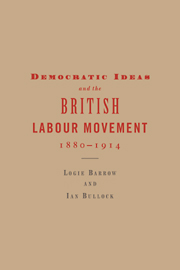Book contents
- Frontmatter
- Contents
- Acknowledgements
- Introduction
- Part 1
- Part 2
- Part 3
- 7 The early 1900s: a hinge period
- 8 Socialists and the state
- 9 Parliamentary socialism? Labour in parliament
- 10 Parliamentary democracy? ‘Fred's obsession’ and the path to the Bradford resolution
- 11 Background to syndicalism: the legacy of the NIGFLTU's failure
- 12 Avoiding the ‘Servile State’. The impact of Syndicalism and Guild Socialism
- 13 1914: an emerging consensus on the eve of Armageddon
- Conclusions
- Appendix: Federation for local Labour historians – and for national
- Index
12 - Avoiding the ‘Servile State’. The impact of Syndicalism and Guild Socialism
Published online by Cambridge University Press: 09 November 2009
- Frontmatter
- Contents
- Acknowledgements
- Introduction
- Part 1
- Part 2
- Part 3
- 7 The early 1900s: a hinge period
- 8 Socialists and the state
- 9 Parliamentary socialism? Labour in parliament
- 10 Parliamentary democracy? ‘Fred's obsession’ and the path to the Bradford resolution
- 11 Background to syndicalism: the legacy of the NIGFLTU's failure
- 12 Avoiding the ‘Servile State’. The impact of Syndicalism and Guild Socialism
- 13 1914: an emerging consensus on the eve of Armageddon
- Conclusions
- Appendix: Federation for local Labour historians – and for national
- Index
Summary
There are three major contrasts between the agitation of the late 1890s and the better known ones of the early 1910s. First, the latter period saw far greater self-confidence and size of struggle. Secondly, there was a greater clarity about ‘leaders’. Thirdly, this clarity was rooted in a wider one about broader aims and strategies. Not surprisingly, these aspects reinforced each other.
First, although the late 1890s actually saw a slow advance in numbers of trade unionists affiliated to the TUC, we have heard these years resounding to the widespread belief that an embattled retreat was taking place. Sometimes, these sounds swelled to something like panic. They came from people of any politics between the Liberals and the SDF and from any level of the trade union movement. Here, the contrast with the mood and the achievement of the later years speaks for itself. These saw the biggest surge in unionism since the period around 1890. It swept up broader groups than many observers, even then, had thought organisable.
Secondly, whereas such ideologists as there were in the ‘New Unionist’ movement of around 1890 seem at first, as we saw, to have thought that leaders and even organisations old and new would let themselves be swamped by the surge towards universal organisation, the Federation-agitators of less than a decade later were all too often hamstrung by an anti-leadership rhetoric which combined cliche with an extraordinary instability and confusion. Their syndicalist successors were often no less prolific on the topic of leaders.
- Type
- Chapter
- Information
- Democratic Ideas and the British Labour Movement, 1880–1914 , pp. 246 - 269Publisher: Cambridge University PressPrint publication year: 1996



